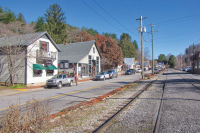Don’t fear the beard
 Though Aaron Stone has always had a love of mayonnaise, lately the condiment has become a real nuisance in his life.
Though Aaron Stone has always had a love of mayonnaise, lately the condiment has become a real nuisance in his life.
“It just gets all stuck in my beard,” he said. “That and soups, it’s just becomes a real mess.”
Get cooking for a good cause: New recipe book to raise money for downtown Waynesville art piece
The Waynesville Public Art Commission has put together a 150-recipe cookbook to benefit future public art pieces.
The Taste of the Great Smoky Mountains Cookbook is $10 and is the culmination a month-long process of collecting recipes from area residents. Many are old recipes handed down from generation to generation. One recipe dates back to a 1966 church cookbook.
Russ Avenue in Waynesville to get Ingles gas station
Ingles has unveiled plans to build a new gas station on Russ Avenue, Waynesville’s most heavily trafficked commercial corridor.
It marks a slight change to previous plans, which called for a gas station along the entrance road leading to Ingles grocery store. The gas station was initially slated to go in between Belk’s and Home Trust Bank. Now, it will go beside Home Trust bank and will front Russ Avenue.
Ingles chain to make big splash in Waynesville
Waynesville will be home to the largest Ingles grocery store in Western North Carolina following major renovations and expansion at its Russ Avenue location.
Shoppers will have a larger beer and wine selection, expanded deli and prepared food counter and café.
Trading autonomy for security: Lake Junaluska weighs whether to merge with town of Waynesville
 When Tom Sigmon tells people in Charlotte that he only lives there part-time, they often ask where he spends the rest of his year. Waynesville, he responds.
When Tom Sigmon tells people in Charlotte that he only lives there part-time, they often ask where he spends the rest of his year. Waynesville, he responds.
For bargain price, Haywood County is proud new owner of shuttered prison
 For a little less than the cost of a cup of coffee, Haywood County is buying the small, closed-down state prison in the Hazelwood community of Waynesville.
For a little less than the cost of a cup of coffee, Haywood County is buying the small, closed-down state prison in the Hazelwood community of Waynesville.
The county is buying the 128-bed minimum security prison from the state for just $1. However, the county will not take ownership of the complex until Jan. 1.
Confederate flag controversery still unsettled in Haywood
Haywood County temporarily backed off its hard-line stance against tiny Confederate flags being stuck in the ground around the base of a memorial for Confederate soldiers on the lawn of the historic courthouse in Waynesville, but has once again started removing the flags.
After getting a complaint about the divisive symbol being placed on the courthouse lawn by Confederate supporters, the county decided to remove the tiny flags. That didn’t last long, however.
Endowment a fitting legacy for Mib and Phil Medford
 When Lori and I moved to Waynesville with our then 2-year-old daughter Megan, we made a conscious choice to build a life in a small town. Our belief was that the pace of life in such a place would be more satisfying for us and more conducive to raising a family.
When Lori and I moved to Waynesville with our then 2-year-old daughter Megan, we made a conscious choice to build a life in a small town. Our belief was that the pace of life in such a place would be more satisfying for us and more conducive to raising a family.
That was a little more than 20 years ago, and I know now we made the right decision — and for more reasons than I could even have imagined at the time. It has been and still is a great place to raise a family, and we have developed many great friendships over the years.
Clock could be running out for denuded Waynesville hillside to get green again
 An earth-moving project that has left a large, visible hillside on Russ Avenue in Waynesville denuded, gouged and barren could continue into the indefinite future despite pressure from the state environmental agency monitoring the site to bring it to a close.
An earth-moving project that has left a large, visible hillside on Russ Avenue in Waynesville denuded, gouged and barren could continue into the indefinite future despite pressure from the state environmental agency monitoring the site to bring it to a close.
Waynesville playground and rec park to get much needed new restrooms
 The vandalized, charred restrooms in the Waynesville Recreation Park will soon get a long-awaited facelift.
The vandalized, charred restrooms in the Waynesville Recreation Park will soon get a long-awaited facelift.









